There is much talk these days about Digital Transformation for businesses. But working with clients, I have come to recognise that most Medium sized businesses struggle with developing an approach for Digital Transformation. Doing a quick Google search results in some high level frameworks such as the one from McKenzie and BCG but most of these only discuss an approach at a very high-level - something along the lines of:
a) Funding the journey.
b) Winning support in the medium term
c) Organising for sustained performance.
Although this is a sensible high-level plan to take a vision to the ground, I feel it leaves practitioners like us, here at Construct Digital, with a big gap to address in turning a transformation vision to reality.
A Segue
As part of my Journey to answer the question, my team and I embarked on a Continuing Education Programme at NUS - Digital Transformation: Rethink your Business for Growth.
The initial few lessons bored me as we discussed the underlying principles and laws that dictate Technology Evolution. Soon though we were talking about Design Thinking as a framework to couch the entire Digital Transformation Journey from a Customer Perspective.
I have often participated in Design Thinking workshop (lasting about 2 hrs) which are often overrun by post-it notes and operate more like a Design Feedback session than a Design thinking workshop.
However, having taken a deep-dive thru the full Design-Thinking Framework, I believe the main stages outlined here are an ideal roadmap to follow when trying to turn a Digital Transformation Roadmap into a tangible plan that can be used to deliver a customer-centric digital transformation - the holy grail of Transformations, in my opinion at least.
What is Design Thinking?
Broadly speaking, The design thinking framework is a popular way for thinking about business problems from the Customer's perspective. This involves understanding the customer's needs and wants, and then coming up with creative solutions that meet those needs. The framework also includes taking action to test out those solutions and see if they work.
According to NUS - There are 6 distinct steps to be executed in a design-thinking solution.
- Understand
- Observer
- Define POV
- Ideate
- Prototype
- Test
Each step in the process is non-trivial and I will discuss some of the more nuanced applications and how these are relevant for the Digital Transformation practitioner.
Design Thinking - Stage 1 - Understand
This stage is all about understanding the customer, their problem and their environment.
In order to do this effectively, you need to go out and talk to your customers! This can be done in a variety of ways - interviews, focus groups, surveys etc. The key here is to get as much information as possible from your customers so that we can identify the Problem Statement & Pain Points in each of the 3 phases of the Customer Experience journey, namely:
a) Pre-Service - when the Customer discovers & explores their options
b) Service - when the Customer makes a purchase with service provider
c) Post-Service - when the Customer reaches out for support or product queries
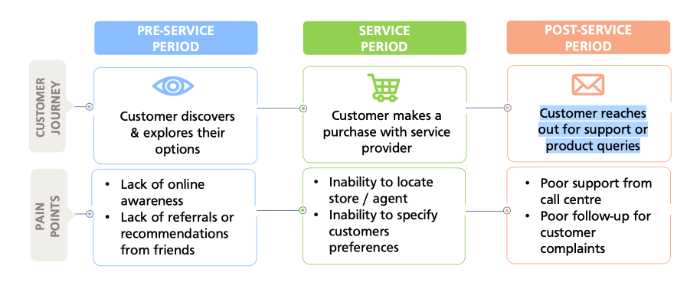
Stages of the Customer Journey and associated Pain Points.
This can then be easily matched with the associated Possible Soutions across the touch-points (do consider Digital Touch-points in particular):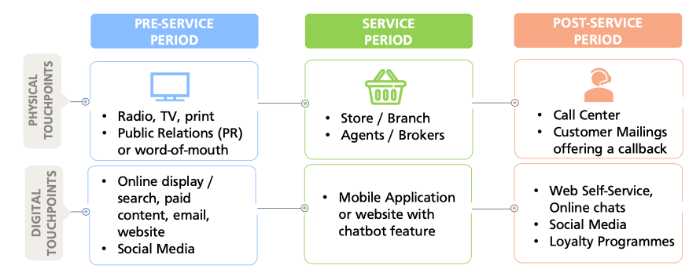
Armed with a High-level understanding of the Customer Journey and Pain Points, we are now in a position to define The Target Audience and work out our Customer Survey questions. (as Marketers you should be familiar with Building A Customer Persona).
So to summarise, the first Understand phase requires us to:
1) Identify the Problem Statement & Pain Points
2) Identify Possible Solutions/ TouchPoints
3) Identify Target Users
4) Design Interview Questionnaires
Design Thinking - Stage-Two - Observe
This stage is about understanding the customer's current behaviour and how they currently try to solve their problem.
In order to do this, we need to observe the customer in their natural environment. This can be done by going on field visits, watching them use your product/service or even just following them around.
This is a critical stage as we can understand how the customer actually goes about solving their problem and what they struggle with - this then informs our next phase of ideation (coming up).
The objective here is to build empathy for the user's existing behaviour, mindset & mental models which will help us design better solutions in future. The formal approach dictates the following Steps:
a) Conduct Ethnographic Research
Simply put this is a study based on the observation of human action, discourse and self-perception. It is used to study people and cultures in which tribes and their traditions were observed by researchers and explained from the perspectives of their subjects. It utilises qualitative methods such as interviews, participant observations, journey mapping and analysing the job to be done.
b) Conduct Interviews
c) Observe behaviors and emotions
d) Interpret the Verbal/Non-verbal Responses
e) Develop an Empathy map
Sample Empathy Map
Assume you’re designing a new sports shoe targeted at 20 to 25- year-old non-athletes who would wear sports shoes not only for their sports activities but also when they head out to school/shopping etc.
Based on our interview with a potential target user, Rick, who is currently 24 years old, we have put together the below Empathy Map.
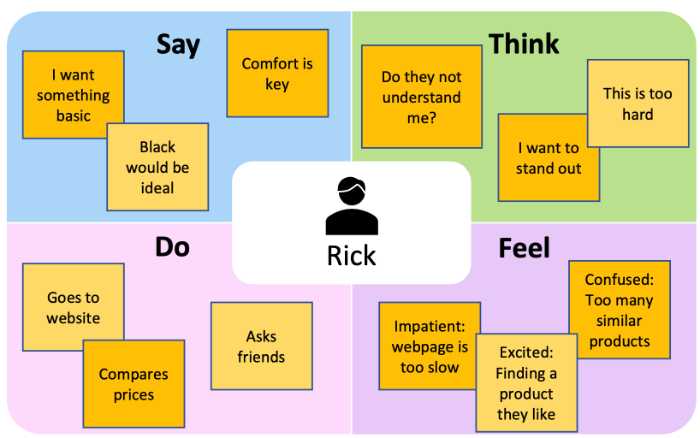 Based on the above Empathy Map, we can see that Rick says that he would like a sports shoe that is basic, ideally black, and that it should be comfortable. However, when reviewing our interview notes, we noticed that Rick would actually like shoes that allow him to stand out from his peers.
Based on the above Empathy Map, we can see that Rick says that he would like a sports shoe that is basic, ideally black, and that it should be comfortable. However, when reviewing our interview notes, we noticed that Rick would actually like shoes that allow him to stand out from his peers.
While he did not verbalise it directly, he often made comments during the interview about other shoes available in the market being “commonly worn by every other person my age” which made it unappealing for him. This was then noted in the “Think” quadrant of the empathy map.
Through this exercise we also observed how Rick would go about searching for a pair of shoes and that price, webpage load speed and a way to differentiate products are key to making his customer journey a pleasant experience.
All of these direct and nuanced needs and desires that we’ve observed will help us when designing our product/service.
Design Thinking - Stage-Three - Define a POV
This stage is about developing a point of view or hypothesis that we can test against our customer's current behaviour and needs. This POV will help us to generate ideas in the ideation stage.
The formal approach dictates the following Steps:
a) Applying our Ethnographic Research
b) Analysing the Customer's Jobs-to-be-done
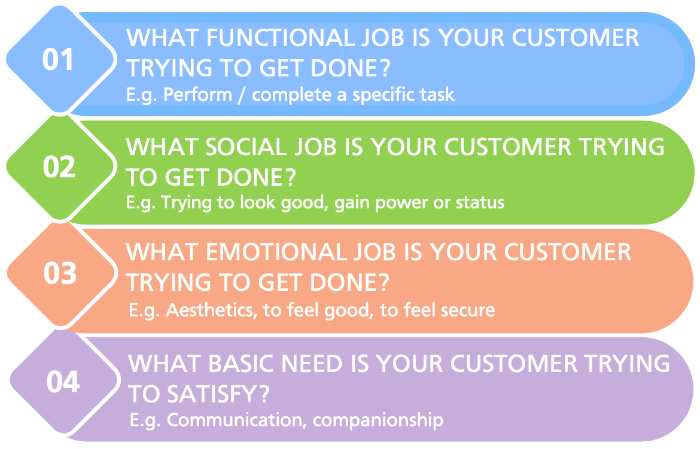
c) Clustering all the insights to Build Narratives
While stories are anecdotes/vignettes about specific events, a narrative is developed to make sense and meaning of these stories.
Narratives, in contrast to stories, are broader and used for 7 key functions:

d) Synthesis to finally construct a Point of View.
using the ethnographic research and customer's job-to-be done, we can start to develop our Point of View (POV).
Rick told us that he is looking for a sports shoe that allows him to standout from his peers. We took this information and generated following POV:
"We believe that there is a market opportunity to appeal to our target user in designing shoes that allow the customer to express their unique personality."
From there we can iterate on our POV by designing multiple prototypes for Rick to choose from and get his feedback on. This will help us to better understand what appeals to him and how we can push the envelope with our design while still staying within budget and time constraints.
Design Thinking - Stage-Four - Ideate

The principle behind this stage of ideation is to go Wide to explore a large solution space.
Why Ideate?
We ideate to put ourselves and our Clients in a state that allows them to:
- Transition from Identifying problems to exploring solutions
- Go Beyond Ordinary Solutions and increase innovation potential.
- Harness Collective Perspectives and strengths of the team.
- Think beyond ordinary solutions and encourage Creativity
3 Methods for Ideation
Brainstorming
There are a few different ways to brainstorm, but the most common is to come up with as many ideas as possible in a short amount of time. This can be done alone or with a group.
When brainstorming, it's important to keep an open mind and not judge any ideas. Just write down everything that comes to mind, no matter how crazy it sounds.
After everyone has had a chance to brainstorm, go through the list and see if there are any ideas that can be turned into a reality.
Clustering of ideas - Sticky post-it notes
This should be a collaborative effort, so it's important to have everyone in the room. Make sure that your team is comfortable and has space to move around freely.
Make different areas for each topic or theme you want to explore. Write down all possible ideas on sticky notes (one idea per note) and place them on their respective area of focus.

Idea Selection - Voting
This approach can be used as the final step of Ideation or after a Brainstorming session. This will help to determine which ideas are worth exploring further.
To do this, you'll need a voting system (e.g. coloured dots, stars etc.) and everyone in the room should have a chance to have a say.
Design Thinking - Stage-Five - Prototyping
This stage is all about creating low-fidelity prototypes that can be tested with our target user. This will help us to get feedback on what works and does not work with the design, which we can then use to iterate on in the next stage of prototyping.
This is typical what I think most people have assumed the Design-Thinking process is all about but without the deep customer understanding develop over the previous 4 stages - this session would be little for more than a Design Review session, with stakeholder giving personal feedback on the work of the team without a proper appreciation of the Customer's Perspective.
Even Prototyping is done iteratively going from initial Lo-fi Prototypes to full functionality over time. The table below distinguishes the tactics and approach used at each point in the prototyping stage.
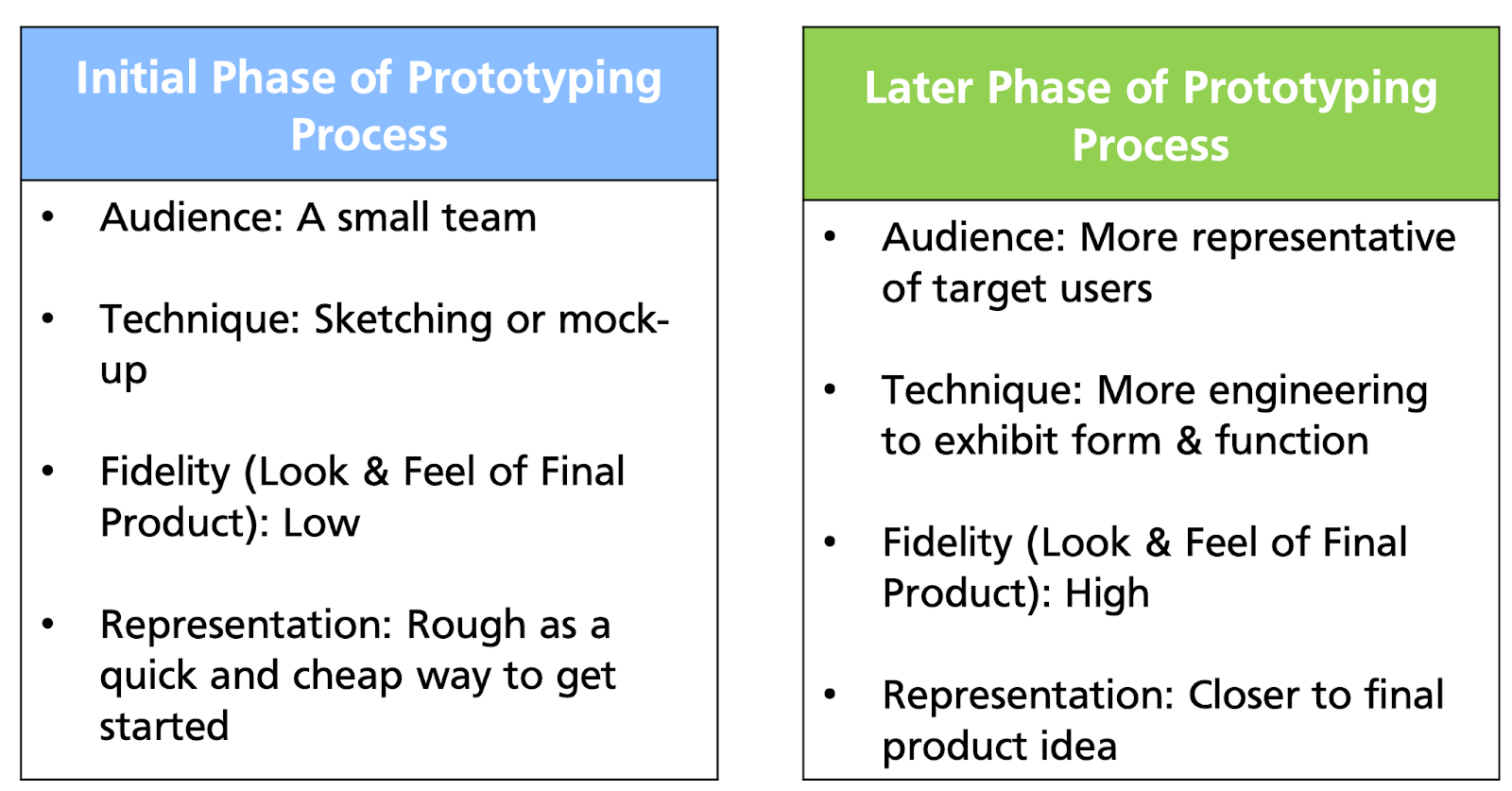
A key Principle to keep in mind for Design Thinking and in particular for the Prototyping Stage is to Fail Quickly & Cheaply. This means do not overthink the quality of your sketches over try to get kerning just right at this stage. We want to be able to turn around our Outputs quickly to spend as much time engaging with the customer on the Prototype.
Design Thinking - Stage-Six - Test and Iterate
This stage melds very tightly with the previous as you will iterate your Prototypes based on what you've learn from your customer to refine your POV and bring them back to test repeatedly until you get to where you need to be with respect to your Customer Experience/Journey.
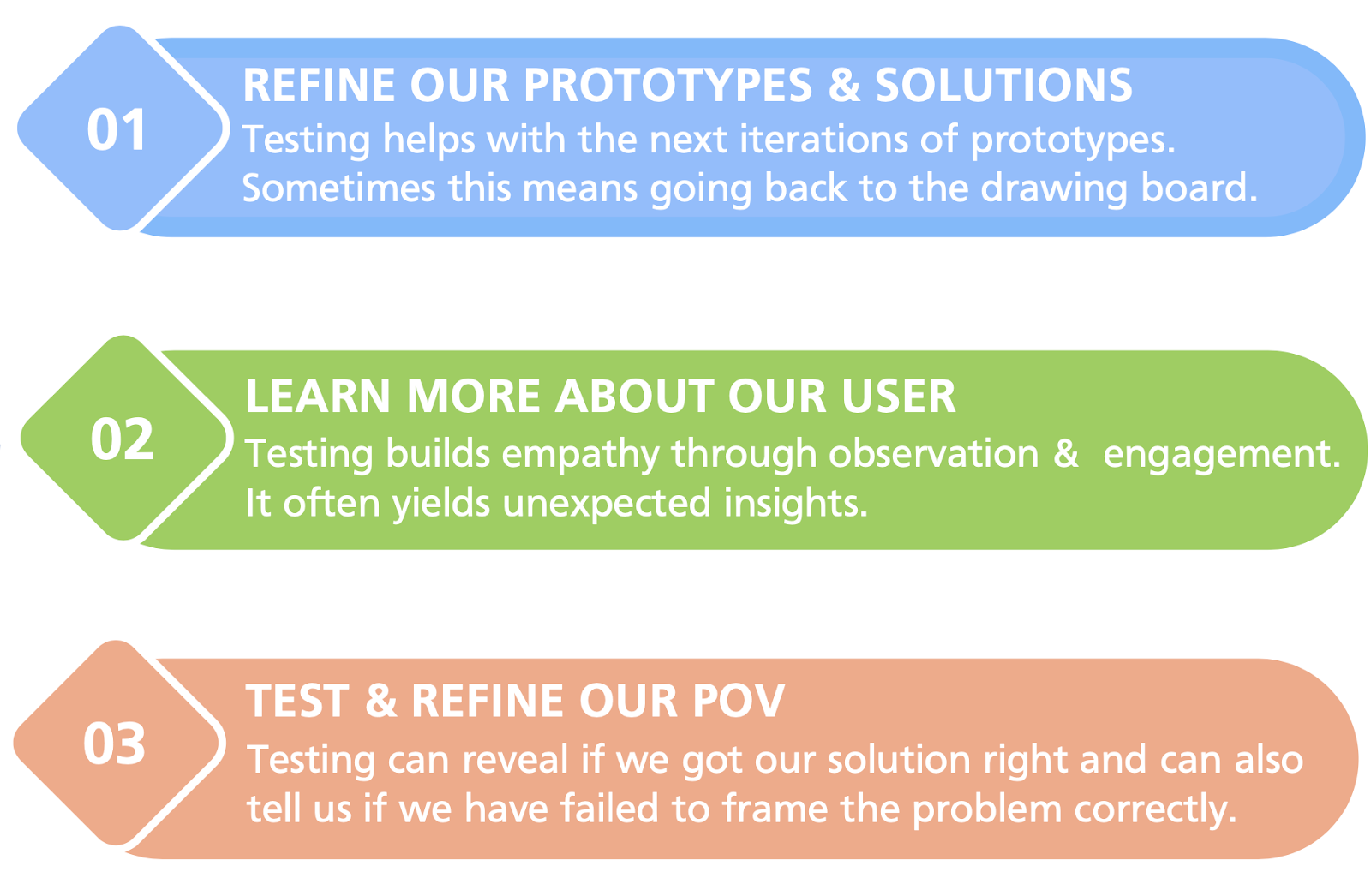
Design-Thinking's Role in the Bigger Digital Transformation Journey
I am not here to say that this Framework is all you need to get your digital transformation journey across the line, but its an invaluable asset to take a grand vision from 20,000 feet up to someplace your Technical and Operational specialist can play are part and be involved in shaping your business's digital future.
As part of the overall Journey, I would place this on level 2 where on Level 1 would sit the High-level Executive Digital Strategy/Vision statements. And below on Level 3 would fit the Business Model Diagrams and Project timelines it would take to make digital transformation a reality.
We know businesses are struggling to keep up with the digital world.
Digital transformation is happening right in front of us, but most businesses don't know where to start or what direction to take. They're overwhelmed by all of the technology and tools out there that they think will help them succeed online. But it's difficult for them to decide which technologies are right for their business, let alone figure out how to use those technologies effectively in conjunction with one another.
Construct Digital is a full-service Transformation agency dedicated exclusively to helping companies digitally transform their organisations through strategic planning, targeted consulting services and customised development solutions. We work closely with our clients during each phase of the process - from initial strategy design through post-implementation support - so we can ensure that your transformation project meets its goals while staying within your budget constraints. If you need an expert who understands both your organization and today's complex Digital environment then contact us today!